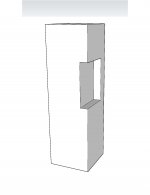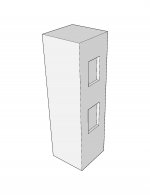ear3
Member
I'm exploring taking a commission to build some display pedestals, but the desired specs look to be a bit more trouble than my schedule permits me to deal with at the moment. I wanted to lay it out here though and get a sense of how you guys might do this work.
You'll see in the examples pictured below that it involves constructing a normal four sided pedestal, but that there be one or two interior boxes the purpose of which is to display a book.
[attachimg=1]
[attachimg=2]
The main pedestal will be constructed from mahogany veneered plywood, but what the artists want is for there to be a seamless transition between the pedestal and the interior box. This would call for doing a 45 degree bevel joint on the cutout, and then constructing the interior box with matching bevels to join and thus hide the plywood edge. I could see maybe being able to pull this off on the second pedestal -- say, use a 45 degree chamfering bit to finish the edges of the two cutouts, with a scrapwood guide for the router bit bearing applied with double sided tape to the outside of the pedestal, and then work by hand with a chisel to square the corners while continuing the 45 degree bevel. But I don't see being able to pull off with any degree of precision the same operation for the cutout for the first pedestal, which, as you see, spans two sides of the pedestal.
An intermediate solution might be to edge band the cutout, and then just build the interior box with straight 90 degree edges. This would still involve some hand tool precision to square the corners, but again, this still gets into some pretty tricky work on thesecond first pedestal. And it's not clear in my mind whether this would even look good, as one would definitely see the abrupt transition between the edge banding and the veneer face of the interior box.
I was considering asking for some slight modifications in the design to make it more straightforward to execute, something where the interior box would be more like a prefabbed insert that would sit slightly proud or overhang the edge of the pedestal, the way, say, a sink nests into the cutout of a countertop.
What do you guys think? Is there perhaps an easier solution I haven't thought of?
You'll see in the examples pictured below that it involves constructing a normal four sided pedestal, but that there be one or two interior boxes the purpose of which is to display a book.
[attachimg=1]
[attachimg=2]
The main pedestal will be constructed from mahogany veneered plywood, but what the artists want is for there to be a seamless transition between the pedestal and the interior box. This would call for doing a 45 degree bevel joint on the cutout, and then constructing the interior box with matching bevels to join and thus hide the plywood edge. I could see maybe being able to pull this off on the second pedestal -- say, use a 45 degree chamfering bit to finish the edges of the two cutouts, with a scrapwood guide for the router bit bearing applied with double sided tape to the outside of the pedestal, and then work by hand with a chisel to square the corners while continuing the 45 degree bevel. But I don't see being able to pull off with any degree of precision the same operation for the cutout for the first pedestal, which, as you see, spans two sides of the pedestal.
An intermediate solution might be to edge band the cutout, and then just build the interior box with straight 90 degree edges. This would still involve some hand tool precision to square the corners, but again, this still gets into some pretty tricky work on the
I was considering asking for some slight modifications in the design to make it more straightforward to execute, something where the interior box would be more like a prefabbed insert that would sit slightly proud or overhang the edge of the pedestal, the way, say, a sink nests into the cutout of a countertop.
What do you guys think? Is there perhaps an easier solution I haven't thought of?


